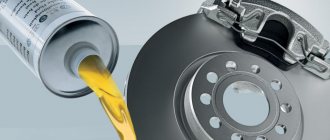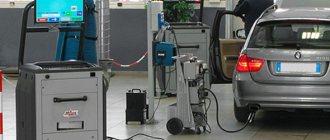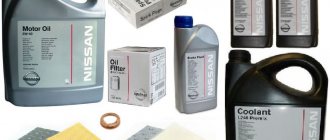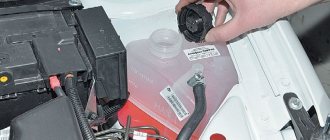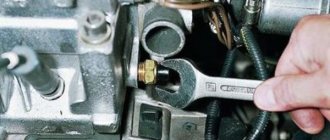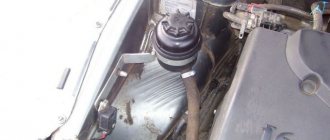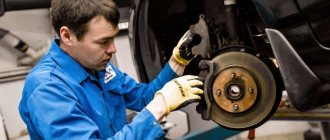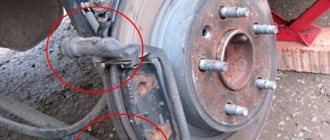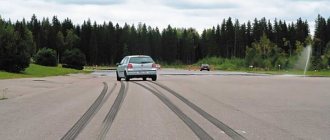Functions and parameters of brake fluid
The main task is to ensure timely, high-quality operation of the brakes. It has several parameters that you need to pay attention to when purchasing. These include:
- Boiling point - this indicator has two values. One refers to the “dry” liquid, the other to the “wet” liquid. During operation, the brake compound absorbs moisture, so the boiling point is greatly reduced. If boiling begins, this will lead to the appearance of air bubbles inside the system and brake failure.
- Viscosity at low temperatures - this indicator indicates at what temperature below zero the composition will begin to thicken and will flow worse through the tubes. For old-style liquids, this temperature was about -20 degrees Celsius. For new ones, this indicator is approximately at 40 degrees.
It is these three points that form the basis of how to choose brake fluid. All compositions also have a different base. This substance should also be taken into account before purchasing. In total, three different bases are used:
- Butyl alcohol and castor oil - a product with such a base is designated BSK and is used in old domestic cars. It does not contain rubber-aggressive components, but other parameters are far from the best. The boiling point is about 115-120 degrees, and it freezes at -20.
- Glycol and polyglycol are the most common formulations. Their boiling point is on average 230 degrees, and they freeze at temperatures below - 40. The disadvantage is their high hygroscopicity. Over a year of operation, the liquid absorbs about 2% of its volume of water. Over the next year there will be about the same amount of use. Because of this, the boiling point decreases, so such a “brake guard” must be changed on time. The glycol-based composition is well suited for cars of both domestic and foreign production. Therefore, when the question arises, for example, which brake fluid is best for the VAZ 2106, you can safely buy just such compounds.
- Silicone - this base is used in products for sports cars. It has a high boiling point; some compounds boil only at 300 degrees. Such liquids do not absorb moisture at all, so they can be changed every 4-5 years. The disadvantage is the high price. In addition, to switch from one type to another, you will have to flush the entire brake system. Not every car will perform better with a silicone-based brake fluid.
When the question arises of which brake fluid to choose, you should pay attention to what is written in the car manual. As a rule, tests of a specific model are carried out using one type of model. It may be indicated only by the name of the standard, or a specific brand may be indicated. You should not deviate from the recommendations. It is better to spend money on purchasing a compound from a declared manufacturer than to risk your safety on the road.
Selecting brake fluid and the procedure for replacing it on a VAZ 2114
For the normal functioning of the vehicle’s vehicle with maximum efficiency, it is important for the car owner to correctly select the working fluid for the hydraulic brake drive. Modern TG, such as “Rosa” and its varieties, are based on polyglycols and this accounts for from 93 to 98 percent of the total composition. The rest is various additives that are necessary to combat oxidation of fuel fluid and prevent corrosion of metal parts of the vehicle.
When purchasing a vehicle, you need to pay attention to the following parameters:
- boiling point, it should be high to reduce the likelihood of plug formation from steam bubbles;
- good viscosity, which characterizes the ability to pump liquid in the system;
- the ability to absorb water, that is, hygroscopicity;
- ability to lubricate internal surfaces;
- neutrality in relation to rubber parts of the braking system;
- oxidation resistance and corrosion resistance.
According to the TZh class for the VAZ 2114, they are marked DOT 3.
How to change the brake fluid on a VAZ 2114 - for the correct actions you need to carefully study the car’s operating manual.
Before starting work, you need to prepare the necessary tools and materials:
- TJ in the amount of 0.5 liters;
- keys and screwdrivers;
- transparent flexible hose;
- container for draining spent fuel oil;
- rags to wipe surfaces, especially plastic and painted ones, since the liquid is toxic and aggressive to these surfaces.
To replace the turbocharger, you need to hire an assistant, because it requires bleeding the system using the brake pedal.
Brake Fluid Standards
There are several brake fluid standards:
- DOT 3 - used for drum brakes. Most often, this liquid is used for American and Japanese cars.
- DOT 4 is the standard for disc brake systems. Now different classes of this standard are used on almost all machines. The best option is a composition marked DOT 4 Class 6.
- DOT 5 is a designation for silicone composition. It is used in sports cars. It cannot be mixed with liquids of other standards.
- DOT 5.1 is a new glycol-based blend that can be mixed with other products.
When the question arises, which is the best DOT 4 brake fluid, it is difficult to give a definite answer. Mixtures from different manufacturers are regularly tested. Based on them, we can draw conclusions about the quality of the product. Now the leading position is occupied by Castrol. This is the best DOT4 brake fluid as it meets all temperature standards. Low hygroscopicity is also an advantage. This fluid can be changed after 60,000 km, while the average for glycol formulations is 30,000 km. The Castrol product is suitable for vehicles of all ages as long as they are DOT 4 approved.
The companies whose products occupy leading positions in the ranking include the German company LiquiMoly. If it is important to find out which DOT4 brake fluid is better, then it makes sense to pay attention to the products of this company. Among the compositions of the same standard, it is distinguished by the presence of various additives and additional components that protect the elements of the vehicle’s hydraulic system. These fluids are suitable for high speed braking. Another advantage is the adaptation of this manufacturer’s fluid for modern cars with an electronic system.
Many Russian motorists choose products from Mobil. It is resistant to low temperatures, does not lose its properties when exposed to moisture and protects all elements of the brake system from corrosion.
Car models and fluids for them
Each vehicle's manual will indicate the type, standard, and sometimes brand of fluid that is suitable for it. Most often, modern models use the DOT 4 standard, but you can take a closer look at several of the most popular models and the compositions suitable for them.
Fans of the domestic auto industry are often concerned with the question of which brake fluid is better for a Priora. According to factory recommendations, this car requires compounds of the DOT 4 standard. During factory tests of the car, products from. Therefore, a motorist can absolutely safely purchase this particular product and not worry about his safety.
A product of this class 6 brand will have the best quality among the entire line. For domestically produced cars, such products will be the best option in terms of price and quality.
Owners of various VAZ cars should also take a closer look at domestically produced products. When the question arises, which brake fluid is best for the VAZ 2107, then in addition to the factory recommendations, it is worth assessing your driving style. For lovers of aggressive driving, a good option would be a brake mixture of the DOT 4 standard from foreign manufacturers. In addition to the aforementioned Castrol, Mobil and LiquiMoly, Shell has also proven itself well.
According to reviews from car owners, the best brake fluid for the VAZ 2110 is the product from RosDOT. This is due to the price/quality ratio, as well as the factory recommendation.
The answer to the question of which brake fluid is best for the VAZ 2114 will be similar. For domestically produced cars, fluids of the same manufacturer are recommended.
For foreign cars, the situation is slightly different, since when testing a car, compounds from absolutely any manufacturer are used. As already mentioned, when choosing a composition, you must first of all be guided by the data from the factory instructions. You should not spare money on an expensive brand indicated by the manufacturer, since the safety of the driver and passengers depends on it.
Some drivers, however, are not afraid of experiments, so among the answers to the question of which brake fluid is best for Lancer 9, you can find positive reviews for domestic products. This model requires 1 liter. You can carry out the replacement procedure in your own garage.
Products of today's market leaders are often used on foreign-made machines. For the Honda Accord 7, the brake fluid produced by LiquiMoly of the DOT 4 standard is better, since it is designed for new cars. When purchasing, you should also pay attention to the expiration date, since you cannot pour expired mixture.
For Mazda cars, the DOT 3 standard is often used; this is what is filled in at the factory. When replacing a Mazda 3, it is better to fill it with fluid manufactured by Castrol. It will last longer, so it will have to be changed less often than similar compounds.
The best brake fluid on Solaris is considered to be the DOT 4 standard. The plant supplies cars with BrakeFluid, but when replacing it, you can use products of any brand that meet the standard.
Purchasing and replacing brake fluid will not be difficult for the motorist if he follows the factory recommendations and replacement instructions. All work can be done at home. If there is not enough experience or the owner of the car does not have time, then you can contact the service. The cost of the work will be low. The main thing to remember is that the brake actuator must be changed on time so that the entire system does not fail during the trip.
Bleeding brakes and replacing brake fluid on a VAZ 2107 car
We replace the brake fluid on the VAZ 2107 according to the frequency of maintenance (see “Periodic maintenance of the VAZ 2107”).
We pump the brakes of the VAZ 2107 to remove air from the brake system and when replacing the brake fluid. If one of the brake circuits depressurizes, it is enough to bleed only this brake circuit, and not the brake system. The order of bleeding the brake circuits of the hydraulic brake system does not matter. We begin pumping the brake circuit of a VAZ 2107 car from the brake mechanism furthest from the main brake cylinder. To carry out the work of bleeding the brakes on a VAZ 2107 car, you will need an assistant, as well as a special 10 mm wrench for brake pipes, a transparent vinyl tube of suitable diameter, a container for draining brake fluid and fresh brake fluid (see “Operating fluids used on VAZ 2107 cars "). The sequence of bleeding the brakes on a VAZ 2107 car
1. We prepare the VAZ 2107 car for operations (see “Preparation of the VAZ 2107 car for maintenance and repair”). 2. Remove the cover of the brake reservoir of the hydraulic brake drive and, if the level is insufficient, add brake fluid to the “MAX” mark into the brake reservoir. 3. Remove the front right wheel from the VAZ 2107 (see “Wheel of the VAZ 2107 - replacement”) and remove the protective rubber cap from the fitting of the brake wheel cylinder.
4. We put a rubber hose on the bleeder fitting and immerse its free end in a container partially filled with brake fluid. We pour the brake fluid into a container so that when bleeding the brakes, air bubbles escaping from the rubber hose are visible. When using a transparent hose, there is no need to pre-fill the reservoir with brake fluid, since the movement of air bubbles in the hose can be visually assessed. 5. An assistant presses the brake pedal 3-5 times and holds it down. 6. Using an 8 mm wrench (10 mm on early VAZ 2107 cars), unscrew the brake bleeder fitting 3/4 of a turn.
At the same time, the brake pedal begins to move, displacing brake fluid through the hose. 7. After the brake pedal has moved all the way, tighten the fitting, after which the assistant releases the brake pedal.
Attention When bleeding the brakes on a VAZ 2107 car, you must periodically check the level of brake fluid in the brake reservoir and, if necessary, add brake fluid.
8. We repeat the operations for pumping the brakes on the VAZ 2107 until air bubbles disappear from the brake fluid coming out of the hose. 9. Remove the hose and put a protective cap on the brake bleeder fitting. 10. We install the previously removed wheel on the VAZ 2107 car. 11. Similarly, bleed the brake mechanism of the left front wheel and close the lid of the brake reservoir of the hydraulic brake system. 12. The rear brake circuit of the hydraulic brake system on a VAZ 2107 is pumped in the same way as the front circuit, starting from the right side of the VAZ 2107. 13. To replace the brake fluid on a VAZ 2107 with a rubber bulb, remove the used brake fluid from the brake reservoir and fill it with fresh one. We pump the front and rear brake circuits of the hydraulic drive until fresh (lighter and more transparent) brake fluid comes out of the fittings of the working brake cylinders.
How to properly bleed the brakes on a VAZ-2106
Almost any repair and maintenance work on the brake system carried out on the classic VAZ-2106 car leads to air entering its lines. Proper pumping eliminates this problem. Only this measure makes it possible to ensure effective braking of all wheels of the vehicle. As follows from the instructions, de-airing must be carried out every time after the system itself or its individual mechanisms have been disassembled, provided that this intervention has led to a loss of tightness. To bleed the brakes on a 2106, it is important to follow a certain order and follow all the steps exactly. More details about the work are described in this article.
How to carry out repairs with an assistant
Getting the job done right is not difficult if you find someone to help you. Bleeding is performed according to the instructions:
- To create pressure in the system, the assistant must press the brake pedal about 9 times at short intervals. After the last press, it must be pushed into the floor and not released.
- At the same time, place the hose on the loosened cylinder fitting. This will allow air to escape from the system.
- The end of the hose is placed in a prepared container with brake fluid. If you do everything correctly, its level will begin to rise, as it will begin to leave the circuit along with the air.
- Bubbles will tell you that air is escaping. As soon as they stop appearing, the air lock has left the system.
- Tighten the fitting and again ask an assistant to pump the system using the pedal about 9 times at short intervals. After completing the work, return the fitting caps to their place.
These manipulations must be carried out with each cylinder affected by the repair in turn. Only rear or front brake cylinders can be made this way. Before bleeding each brake mechanism, it is necessary to add fluid to the expansion tank, as it will leak out during the work. Pour only new fluid, and not the one you have in the pumping container. After all, the latter contains air bubbles that will reduce all your work to zero.
Features of the braking system of classic Lada cars
The first cars of the model in question rolled off the assembly line about 40 years ago, and therefore many of its components seem somewhat exotic to modern car enthusiasts. For this reason, before pumping the brakes yourself, it would be a good idea to become more familiar with their design specifics. Without understanding the principles of operation, it is impossible to provide competent maintenance, much less repair of any unit.
So, first of all, it should be said that you intend to bleed a hydraulic, dual-circuit brake system. This is exactly what was installed on all Zhigulis, including 2106.
The bottom line is that the hydraulics are divided into two completely unrelated units. In general, this scheme is used on many cars in one variation or another. The Italian prototype of the Zhiguli had parallel contours, that is, the blocking was carried out along the axes - front and rear.
This measure is designed to increase the safety level of 2106. In the event that one working cylinder fails, stopping is ensured by the second. It is quite convenient and, what is important, very reliable.
The 2106 brake system contains a special fluid that circulates in sealed lines. Its composition promotes the transfer of kinetic impulse without loss of its intensity.
Theoretically, if you reliably protect the system from air and never overheat it, then it can function forever. The trouble is that an increase in the temperature of the liquid leads to its boiling, as a result of which a gas is formed, the state of aggregation of which no longer changes. To get rid of bubbles, you need to bleed the system.
When you need pumping
The operation manual clearly states the cases in which it is necessary to ventilate the lines of the brake system 2106. In particular, such actions are performed when:
- VAZ cylinders were repaired or completely replaced;
- new hoses or other pipeline elements were installed;
- any intervention was carried out, accompanied by loss of tightness of any circuit or tank;
- the previous deaeration was carried out with errors and there were still bubbles in the system.
In some cases, it is not necessary to pump the VAZ circuits. This is about:
- disc groove;
- drum repair;
- installing new pads;
- work related to adjusting the hand brake.
None of this involves tampering with the hydraulic system.
As practice shows, in the 2106 model the GTZ (brake master cylinder) very often fails. As a result, the entire system ceases to function properly. Any repair of a unit or its complete replacement involves disconnecting the lines leading to it, which clearly leads to the entry of air. Because of this, when the work is completed and the gas turbine engine is installed in place, the system must be pumped.
Also caused by the failure of the vacuum booster, the malfunction of the brake system dictates the need to remove the mentioned unit from the VAZ-2106 vehicle, which is accompanied by disconnection of the cylinder and lines. Accordingly, depressurization occurs, the consequences of which can be eliminated by pumping. There is no need for this procedure if the cylinder was removed without disconnecting the fittings from it.
Finally, deflation will have to be done after replacing the brake fluid. This operation, by the way, requires additional flushing of the system - its completion will be indicated by the release of a completely transparent composition from the line.
As noted above, the VAZ-2106 has two brake circuits, which means that if work was carried out on only one, then only it should be bled. When manipulations were performed on one of the wheels, then complete removal of air bubbles must be carried out on both.
Vehicle malfunctions leading to replacement of the vehicle with a VAZ 2114
The hydraulic brake system includes many different parts that allow you to operate the brakes using hydraulic fluid. It includes:
- a tank that is attached to the gas turbine engine and is intended for filling the fuel fluid;
- metal pipelines of both circuits;
- flexible brake hoses of front and rear wheels;
- GTZ installed in the engine compartment;
- working brake cylinders of front and rear wheels;
- dual-circuit pressure regulator;
- a sensor showing at what level the fuel fluid is located;
- a vacuum booster, the task of which is to create working fluid pressure in the pipelines of the circuits in order to ensure effective operation of the brake systems on the wheels during braking.
A car’s vehicle is one of the main systems that ensures the safety of the driver and passengers of the car, therefore regular preventive inspection of all elements of the vehicle is mandatory for the owner of the car.
The brake fluid on the VAZ 2114, according to the recommendations of technical specialists, is replaced every three years or no more than after 45 thousand kilometers of the vehicle.
At the same time, during the operation of a vehicle, malfunctions periodically occur in its braking system and especially in the hydraulic drive, leading to the need to replace the brake fluid. Knowledge of these malfunctions and the reasons leading to them can help the driver avoid serious troubles on the road, since in this case he can promptly identify the failure and take measures to eliminate it.
Nuances of pumping
During the deflation process, it is also recommended to check the condition of the brake discs, pads and hoses. It is important to make sure there are no damages, cracks or other defects. Be sure to pay attention to the rear drums. The brake pads located near them need periodic adjustment. Without the latter, efficient operation of the circuit is impossible.
If the system is pumped correctly, then an absolutely identical force will be applied to each side of the car. When a VAZ moves away from the straight line during braking, this means that there is air in the circuit. Ignoring this sign is very dangerous.
Please note that drift to the right indicates the presence of bubbles in the brake elements located on the left, etc.
The weaker the locking on one side is, the more powerful the car is pulled in the opposite direction.
On the VAZ-2106, pumping begins from the front circuit, and upon completion of work, switches to the rear circuit.
If partial deflation is necessary, then it is done along the entire axle, and not at all along one of the wheels installed on it.
Dismantling and replacing the gas turbine engine requires full bleeding of all circuits.
It is advisable to work in pairs with an assistant - it is quite difficult to carry out all the procedures alone, because you will have to simultaneously press the brake pedal and loosen the fittings on the caliper.
Lada 2109 › Logbook › Bleeding the brakes
Bleeding is a frequently carried out measure aimed at restoring and increasing the efficiency of the braking system.
It is necessary to pump the brakes after any intervention in the design of the brake system - repair, replacement of components, change of brake fluid, cylinders, vacuum booster, etc. Bleeding allows you to remove air that has entered there from the line.
If air is in the system, at some point (as practice shows, this always turns out to be the most inopportune moment) the pedal simply will not respond to pressure. Therefore, you will not be able to slow down or stop the car. And this despite the fact that you have new brakes after replacement.
Tank with TJ Tank with TJ
Rules for performing work
The VAZ 2109 is equipped with a brake system divided into two circuits - rear and front.
If you replaced only the front or only the rear cylinders, or other components, bleeding may well be carried out only along one of the circuits where the repair was carried out. All other situations related to removing the master brake cylinder and replacing pipes require mandatory bleeding of the entire system.
Before you bleed the brakes, you should learn about the bleeding procedure. If you do not follow it, the work will not give the desired effect, and therefore the pedal may not work again.
Rear right wheel
Front left wheel
Rear left wheel
Front right wheel
Follow this correct bleeding sequence, starting with the rear right and ending with the front right. A similar recommendation is indicated for all VAZ 2109 operating manuals.
Process in progress Process in progress
By properly preparing for the upcoming brake system bleeding, you can seriously save on car service costs. Watch the video, read our instructions to gain the necessary experience and upgrade the vehicle yourself
Among the preliminary activities, we highlight the following. 1.Check the current level of brake fluid in the expansion tank. If it is less than the MAX mark, you will need to add a little fuel fluid to the required level. 2. Prepare any empty plastic container by pouring a small amount of brake fluid into it. 3. Find a hose of sufficient length, the diameter of which will correspond to the diameter of the brake cylinder fittings. 4.If the car is on a lift, that is, the rear wheels are hanging, you will need to block the pressure regulator. To do this, simply insert a flathead screwdriver between the piston and the plate. 5. Be sure to invite a friend or assistant. One person is needed to help build up pressure inside the brake system. 6.Loosen the tension on the fittings before starting work.
Now let’s proceed directly to bleeding the brake system of your VAZ 2109. By following certain instructions and observing the sequence of actions, you will be able to complete the task more easily with four hands. 1.Ask an assistant to press the brake pedal about 9 times. This is how pressure will be created inside the system. The pedal does not need to be lowered after the last press. It is necessary to keep it pressed to the floor. 2.At this time, you should put the rubber hose on the cylinder fitting. By loosening the fitting, air is released from the system. 3.Brake fluid will begin to leave the system along with air. 4. It is not difficult to determine the presence of air inside the vehicle, since bubbles appear in the brake fluid in the container into which the mixture is drained. Make sure that the other end of your hose is lowered inside the container and touches the TJ that was poured there in advance. 5.Tighten the fitting, after which the assistant will need to create pressure in the system again. That is, the brake pedal is pressed again. 6.Using the instructions provided and the sequence of pumping through the wheels, excess air is expelled from the entire brake system of the VAZ 2109. 7.Pump until you get rid of all the air, that is, the fuel fluid begins to come out without forming bubbles inside the container.
During the pumping process, the coolant will gradually come out of the expansion tank. As the quantity decreases, do not forget to fill it with new composition. It is not worth pouring fuel fluid from the container for pumping, since, as you remember, there are air bubbles there.
Press the brake pedal
Having completed the procedure for bleeding the brake system, tighten the fittings and put the caps on them.
It is not always possible to invite an assistant, and some even prefer to carry out repairs on their car without outsiders.
It is quite possible to pump up a vehicle with two hands. To work, you will need an Aerator, available in all markets and in any automotive stores. Such a purchase will cost 80-150 rubles.
A simple example of an aerator
The work will look like this: •Connect the wheel valve with the expansion tank valve. This way, the air from the wheel will be directed to the TJ tank, creating the necessary pressure; •Lift the car using a jack; •Remove the wheel, unscrew the bleeder fitting; •The created pressure will allow the liquid to be expelled from the system.
The pressure obtained from the wheel can easily be replaced by a connected pump or compressor.
Do not rush to go out on the road, because after pumping the vehicle still needs to be checked.
To do this: 1. Drive onto a road where there are almost no cars. In this case, the asphalt must be dry and smooth. 2. Accelerate to approximately 40 kilometers per hour. 3. Depress the brake pedal, blocking the wheels. 4.Keep your foot on the pedal until the car comes to a complete stop. 5.Measure the braking distance using a tape measure. 6.Repeat the procedure, driving in the opposite direction. 7.Check the braking distance readings. If they are normal, you can safely continue to operate your own car.
What is needed for pumping
In order to bleed the brake system installed on a VAZ-2106 as quickly and efficiently as possible, you should prepare all the required tools in advance. In particular, you will need:
- an 8 mm wrench (to unscrew the fitting) and also a wheel wrench;
- jack;
- an ordinary three-liter jar;
- a thin rubber or silicone hose that can fit tightly onto the air fitting;
- pliers;
- wiping ends;
- VD-40.
How to check the result of your work
Find a clear, dry section of paved road to check the brake bleeding.
You need to accelerate to 40 kilometers per hour, and then press the brake pedal and do not release it until it comes to a complete stop. Take a tape measure and measure the resulting braking distance - its beginning will be clearly visible on the asphalt. If the brakes work as they should, the length should be 12.2 meters. To ensure that the braking system is effective, repeat the procedure in reverse. Compare the measurement results. If the car is tuned perfectly, the braking distance will be the same. If repair work and pumping are carried out correctly, the measurements will be within normal limits.
Deaeration procedure
To bleed the front axle, the car must be jacked up and supported on racks. Further:
- the wheels are removed from it;
- make sure that there is the required volume of brake fluid in the reservoir;
- place a suitable tube located on the caliper onto the air fitting;
- the second end of the latter is placed in a jar, into which about 1-2 glasses of brake fluid are first poured.
The fitting is treated with WD-40 at the very beginning, this will make it easier to unscrew the cap. After about five minutes it is loosened with an 8mm wrench.
Make sure the tip of the tube is immersed in the brake fluid - this is important.
Upon completion of the preparatory stage, pumping begins. For this:
- the pedal controlling the hydraulic drive is pressed at least 5 times in a row;
- then it is held in the lower position and the caliper fitting is released in parallel;
- when liquid begins to come out of the system along with bubbles, they begin to press the pedal again;
- the main stage ends as soon as the air stops flowing.
To be sure, make a few more pumping movements with the pedal and again lock it in the lower position. At the same time, the fitting must be completely screwed in.
Finally, release the pedal and press it again, and then proceed to pump the other wheel. Having finished with the front axle, return the car to a horizontal position, lift the stern and repeat all the steps on the rear.
If you have the opportunity to use a ramp, pneumatic lift or inspection pit, then it is better to carry out deaeration on them. In this situation, there is no need to remove the wheels.
REPLACEMENT
Some drivers don’t even know where to fill the brake fluid in the VAZ 2114 (even though the VAZ brake fluid reservoir is visible), not to mention the rules. DOT-4 needs to be added only if its level in the tank has dropped below the halfway point between the MIN and MAX marks. To do this, simply unscrew the tank cap and fill it to the top mark. The brake fluid volume should not exceed the maximum mark.
Do not under any circumstances mix products from different manufacturers and brands. This may lead to system failure, which will adversely affect your financial situation when contacting the service. Be sure to ask an expert how to add brake fluid.
In general, if all necessary conditions and rules are observed, everything is done quite simply. Any measures to normalize the operation of a car require certain tools and special clothing. This should not be forgotten, since contact with human skin of chemicals contained in fuels and lubricants is extremely dangerous to health.
But whatever one may say, in the quest for durability and reliability of your car there is nothing you can do. The acquired skills can be applied not only to the VAZ 2114, but also to other models of the domestic automobile industry. For example, the VAZ 2115 has an absolutely identical device.
Functions and parameters of brake fluid
The main task is to ensure timely, high-quality operation of the brakes. It has several parameters that you need to pay attention to when purchasing. These include:
- Boiling point - this indicator has two values. One refers to the “dry” liquid, the other to the “wet” liquid. During operation, the brake compound absorbs moisture, so the boiling point is greatly reduced. If boiling begins, this will lead to the appearance of air bubbles inside the system and brake failure.
- Viscosity at low temperatures - this indicator indicates at what temperature below zero the composition will begin to thicken and will flow worse through the tubes. For old-style liquids, this temperature was about -20 degrees Celsius. For new ones, this indicator is approximately at 40 degrees.
It is these three points that form the basis of how to choose brake fluid. All compositions also have a different base. This substance should also be taken into account before purchasing. In total, three different bases are used:
- Butyl alcohol and castor oil - a product with such a base is designated BSK and is used in old domestic cars. It does not contain rubber-aggressive components, but other parameters are far from the best. The boiling point is about 115-120 degrees, and it freezes at -20.
- Glycol and polyglycol are the most common formulations. Their boiling point is on average 230 degrees, and they freeze at temperatures below - 40. The disadvantage is their high hygroscopicity. Over a year of operation, the liquid absorbs about 2% of its volume of water. Over the next year there will be about the same amount of use. Because of this, the boiling point decreases, so such a “brake guard” must be changed on time. The glycol-based composition is well suited for cars of both domestic and foreign production. Therefore, when the question arises, for example, which brake fluid is best for the VAZ 2106, you can safely buy just such compounds.
- Silicone - this base is used in products for sports cars. It has a high boiling point; some compounds boil only at 300 degrees. Such liquids do not absorb moisture at all, so they can be changed every 4-5 years. The disadvantage is the high price. In addition, to switch from one type to another, you will have to flush the entire brake system. Not every car will perform better with a silicone-based brake fluid.
When the question arises of which brake fluid to choose, you should pay attention to what is written in the car manual. As a rule, tests of a specific model are carried out using one type of model. It may be indicated only by the name of the standard, or a specific brand may be indicated. You should not deviate from the recommendations. It is better to spend money on purchasing a compound from a declared manufacturer than to risk your safety on the road.
Selecting brake fluid and the procedure for replacing it on a VAZ 2114
For the normal functioning of the vehicle’s vehicle with maximum efficiency, it is important for the car owner to correctly select the working fluid for the hydraulic brake drive. Modern TG, such as “Rosa” and its varieties, are based on polyglycols and this accounts for from 93 to 98 percent of the total composition. The rest is various additives that are necessary to combat oxidation of fuel fluid and prevent corrosion of metal parts of the vehicle.
When purchasing a vehicle, you need to pay attention to the following parameters:
- boiling point, it should be high to reduce the likelihood of plug formation from steam bubbles;
- good viscosity, which characterizes the ability to pump liquid in the system;
- the ability to absorb water, that is, hygroscopicity;
- ability to lubricate internal surfaces;
- neutrality in relation to rubber parts of the braking system;
- oxidation resistance and corrosion resistance.
According to the TZh class for the VAZ 2114, they are marked DOT 3.
How to change the brake fluid on a VAZ 2114 - for the correct actions you need to carefully study the car’s operating manual.
Before starting work, you need to prepare the necessary tools and materials:
- TJ in the amount of 0.5 liters;
- keys and screwdrivers;
- transparent flexible hose;
- container for draining spent fuel oil;
- rags to wipe surfaces, especially plastic and painted ones, since the liquid is toxic and aggressive to these surfaces.
To replace the turbocharger, you need to hire an assistant, because it requires bleeding the system using the brake pedal.
Brake Fluid Standards
There are several brake fluid standards:
- DOT 3 - used for drum brakes. Most often, this liquid is used for American and Japanese cars.
- DOT 4 is the standard for disc brake systems. Now different classes of this standard are used on almost all machines. The best option is a composition marked DOT 4 Class 6.
- DOT 5 is a designation for silicone composition. It is used in sports cars. It cannot be mixed with liquids of other standards.
- DOT 5.1 is a new glycol-based blend that can be mixed with other products.
When the question arises, which is the best DOT 4 brake fluid, it is difficult to give a definite answer. Mixtures from different manufacturers are regularly tested. Based on them, we can draw conclusions about the quality of the product. Now the leading position is occupied by Castrol. This is the best DOT4 brake fluid as it meets all temperature standards. Low hygroscopicity is also an advantage. This fluid can be changed after 60,000 km, while the average for glycol formulations is 30,000 km. The Castrol product is suitable for vehicles of all ages as long as they are DOT 4 approved.
The companies whose products occupy leading positions in the ranking include the German company LiquiMoly. If it is important to find out which DOT4 brake fluid is better, then it makes sense to pay attention to the products of this company. Among the compositions of the same standard, it is distinguished by the presence of various additives and additional components that protect the elements of the vehicle’s hydraulic system. These fluids are suitable for high speed braking. Another advantage is the adaptation of this manufacturer’s fluid for modern cars with an electronic system.
Many Russian motorists choose products from Mobil. It is resistant to low temperatures, does not lose its properties when exposed to moisture and protects all elements of the brake system from corrosion.
Car models and fluids for them
Each vehicle's manual will indicate the type, standard, and sometimes brand of fluid that is suitable for it. Most often, modern models use the DOT 4 standard, but you can take a closer look at several of the most popular models and the compositions suitable for them.
Fans of the domestic auto industry are often concerned with the question of which brake fluid is better for a Priora. According to factory recommendations, this car requires compounds of the DOT 4 standard. During factory tests of the car, products from. Therefore, a motorist can absolutely safely purchase this particular product and not worry about his safety.
A product of this class 6 brand will have the best quality among the entire line. For domestically produced cars, such products will be the best option in terms of price and quality.
Owners of various VAZ cars should also take a closer look at domestically produced products. When the question arises, which brake fluid is best for the VAZ 2107, then in addition to the factory recommendations, it is worth assessing your driving style. For lovers of aggressive driving, a good option would be a brake mixture of the DOT 4 standard from foreign manufacturers. In addition to the aforementioned Castrol, Mobil and LiquiMoly, Shell has also proven itself well.
According to reviews from car owners, the best brake fluid for the VAZ 2110 is the product from RosDOT. This is due to the price/quality ratio, as well as the factory recommendation.
The answer to the question of which brake fluid is best for the VAZ 2114 will be similar. For domestically produced cars, fluids of the same manufacturer are recommended.
For foreign cars, the situation is slightly different, since when testing a car, compounds from absolutely any manufacturer are used. As already mentioned, when choosing a composition, you must first of all be guided by the data from the factory instructions. You should not spare money on an expensive brand indicated by the manufacturer, since the safety of the driver and passengers depends on it.
Some drivers, however, are not afraid of experiments, so among the answers to the question of which brake fluid is best for Lancer 9, you can find positive reviews for domestic products. This model requires 1 liter. You can carry out the replacement procedure in your own garage.
Products of today's market leaders are often used on foreign-made machines. For the Honda Accord 7, the brake fluid produced by LiquiMoly of the DOT 4 standard is better, since it is designed for new cars. When purchasing, you should also pay attention to the expiration date, since you cannot pour expired mixture.
For Mazda cars, the DOT 3 standard is often used; this is what is filled in at the factory. When replacing a Mazda 3, it is better to fill it with fluid manufactured by Castrol. It will last longer, so it will have to be changed less often than similar compounds.
The best brake fluid on Solaris is considered to be the DOT 4 standard. The plant supplies cars with BrakeFluid, but when replacing it, you can use products of any brand that meet the standard.
Purchasing and replacing brake fluid will not be difficult for the motorist if he follows the factory recommendations and replacement instructions. All work can be done at home. If there is not enough experience or the owner of the car does not have time, then you can contact the service. The cost of the work will be low. The main thing to remember is that the brake actuator must be changed on time so that the entire system does not fail during the trip.
Vehicle malfunctions leading to replacement of the vehicle with a VAZ 2114
The hydraulic brake system includes many different parts that allow you to operate the brakes using hydraulic fluid. It includes:
- a tank that is attached to the gas turbine engine and is intended for filling the fuel fluid;
- metal pipelines of both circuits;
- flexible brake hoses of front and rear wheels;
- GTZ installed in the engine compartment;
- working brake cylinders of front and rear wheels;
- dual-circuit pressure regulator;
- a sensor showing at what level the fuel fluid is located;
- a vacuum booster, the task of which is to create working fluid pressure in the pipelines of the circuits in order to ensure effective operation of the brake systems on the wheels during braking.
A car’s vehicle is one of the main systems that ensures the safety of the driver and passengers of the car, therefore regular preventive inspection of all elements of the vehicle is mandatory for the owner of the car.
The brake fluid on the VAZ 2114, according to the recommendations of technical specialists, is replaced every three years or no more than after 45 thousand kilometers of the vehicle.
At the same time, during the operation of a vehicle, malfunctions periodically occur in its braking system and especially in the hydraulic drive, leading to the need to replace the brake fluid. Knowledge of these malfunctions and the reasons leading to them can help the driver avoid serious troubles on the road, since in this case he can promptly identify the failure and take measures to eliminate it.
Malfunctions in the vehicle resulting in the need to replace the vehicle:
- Leaks from the working brake cylinders leading to significant loss of fuel fluid.
- The formation of air pockets in main pipelines and flexible hoses, which are formed as a result of leaks in vehicle units.
- Rupture or fraying in the flexible hoses on the wheels, in this case the brake hoses on the VAZ 2114 need to be replaced. Damage to metal pipelines is also possible; as a rule, a leak forms due to “chasing”. In both cases, the liquid quickly flows out of the vehicle, so at the slightest sign of disorder in the vehicle, these parts should be checked first.
- Damage or swelling of the sealing rings in the GTZ or wheel cylinders. This also leads to leaks.
- Leakage of fuel fluid through the sealing rings of the rear wheel RD pusher.
- There may be a leak in one of the brake circuits. In this case, partial failure of the brake pedal occurs.
- Quite rarely, but metal pipelines become clogged.
- As a result of mechanical damage, failures of the GTZ, RTC, vacuum unit and other vehicle elements are possible. To eliminate these damages on the VAZ 2114, replacing the brake fluid is a prerequisite.
